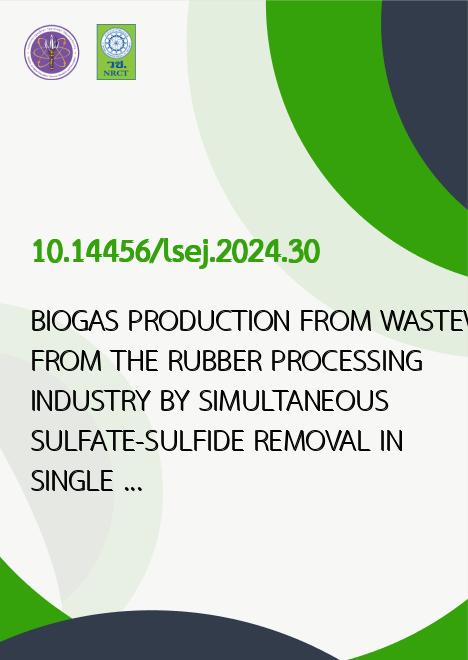
|
BIOGAS PRODUCTION FROM WASTEWATER FROM THE RUBBER PROCESSING INDUSTRY BY SIMULTANEOUS SULFATE-SULFIDE REMOVAL IN SINGLE STAGE DIGESTER |
|---|---|
| รหัสดีโอไอ | |
| Creator | Wikanda Thongnueakhaeng |
| Title | BIOGAS PRODUCTION FROM WASTEWATER FROM THE RUBBER PROCESSING INDUSTRY BY SIMULTANEOUS SULFATE-SULFIDE REMOVAL IN SINGLE STAGE DIGESTER |
| Contributor | Supandee Maneelok |
| Publisher | Pibulsongkram Rajabhat University |
| Publication Year | 2567 |
| Journal Title | Life Sciences and Environment Journal |
| Journal Vol. | 25 |
| Journal No. | 2 |
| Page no. | 396-408 |
| Keyword | biogas, sulfate removal, wastewater treatment, latex transforming wastewater |
| URL Website | https://ph01.tci-thaijo.org/index.php/psru/index |
| Website title | Life Sciences and Environment Journal |
| ISSN | 2773-9201 |
| Abstract | This study focuses on developing the capability to produce biogas from wastewater contaminated with high organic and sulfate concentration, through an integrated sys-tem of sulfate removal and biogas production within a single unit. The experiments were conducted under anaerobic conditions with Sulfate/Nitrate (S/N) of 0.5, 1.0, 1.5, 2.0 and 2.5. Additionally, the applicability of the system in industry was investigated. This study indicates that operating at an S/N of 2.0 provided the most efficient bio-gas production, with a biogas generation of 0.36±0.02 L/gCODremoved. The composition comprised methane and hydrogen sulfide at 70.2±0.2% and 8.0±0.1 ppm, respective-ly. Moreover, this condition also showed high efficiency in COD, sulfate and sulfide removal. The average COD in influent and effluent was 12,818.25±13.25 and 1,770.42±10.12 mg/L, respectively. The efficiency in COD treatment was 86.19%. In addition, the system was applied in a rubber sheet manufacturing plant. Wastewater that contains nitrogen in form of nitrate-nitrite from the nitrification system was circu-lated into the biogas production system to control the S/N ratio in influent at 2.0. It was found that the system could produce more methane gas compared to the pre-vious system that did not include sulfate-sulfide removal process. Through energy balance, electrical energy used for wastewater pump and aerator in the nitrification process was 1.5 kWh per day, while it could produce 9.87 m3/day of methane gas. This implies that it can substitute 11.8 kWh per day of electricity. |